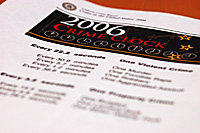By Janis Siegel, JTNews Correspondent
According to the latest hate-crime figures put out by the 2006 Federal Bureau of Investigation’s Uniform Crime Report, Jews in the United States bore the brunt of the majority of religiously based hate crimes reported that year, and African Americans suffered the overwhelming majority of racially based hate crimes.
The number of criminal incidents, defined by the targeting of property or persons with a clear bias toward their race, religion, ethnicity, national origin, sexual orientation, or disability, rose nearly 8 percent in 2006, topping out at 7,772 individual reports, indicating an upward trend from the decade’s lowest figure of 7,173 in 2005.
The 2006 report contains the most recently available data, but preliminary findings for the first half of 2007 show that violence went down by 1.8 percent.
Within the 4,000 racially motivated hate crimes that were reported in 2006, blacks were targeted in 2,640 of them.
Out of the 1,374 religiously based hate crimes that were officially included in the statistics, 967 of them rose to the level of anti-Semitic, targeting Jews or their property.These represented 12.5 percent of all the hate crime cases reported in 2006.
That number was down, however, from the decade’s highest year for reported anti-Semitic incidents, which was 1,109 in 1999, but it is significantly above its lowest number of 848, recorded in 2005.
Far lower by comparison, the grouping with the second highest number of reported targeted religious criminal attacks was anti-Islamic hate crimes, showing 156 incidents. Those numbers were followed by a less specific FBI category, “Anti-Other Religion,” that totaled 128.
These figures represented 12,600 law enforcement agencies in the U.S. that submitted hate crime reports in 2006. There are 17,700 law enforcement agencies across the country.
In Washington, 56 out of the 253 law enforcement agencies submitted hate crime reports, totaling a final tally of 177 incidents that occurred in their jurisdictions during 2006.
Since the reporting of hate crimes is voluntary and incidents are vastly under-reported in general, according to both government and private sources, the numbers don’t really tell the whole story when it comes to “bias motivation” and crime.
No one knows why many hate crimes go unreported, according to Hilary Bernstein, regional director of education and interim regional director for the Pacific Northwest office of the Anti-Defamation League, but as someone who works with these issues on a daily basis, she considers the insufficient training of law enforcement and the lack of education about the nature of the crimes as strong possibilities.
“It all comes back to education,” said Bernstein. “Our main role is to educate law enforcement to recognize the markers of hate crimes. We also hold training sessions with regard to hate groups, and meet with boards and staff to help them recognize when to report things.”
The ADL is often one of the first places anyone in the region calls if they experience discriminatory behavior, Bernstein said.
“We get calls on a daily basis from individuals who want to report incidents,” said Bernstein. “We keep an accurate log. In the last six months we’ve had a total of 60 reports.”
Bernstein said the people who call are a diverse group that includes students, synagogue members, retirees at senior centers, and school bus drivers. Some have received hate mail and others have been verbally harassed or have been the victim of anti-Semitic remarks.
In addition to responding to complaints from the general public, the ADL has also been tracking anti-Semitic activity on college campuses since 1984, believing that they are a microcosm of the larger society and reflect the mood of the country as a whole.
According to the organization’s 2004 report, they identified more than 70 “official” reports of assault, personal harassment, and vandalism aimed at Jewish students on campuses throughout the U.S.
Locally, at the University of Washington, the campus police department reported no hate crime activity in the three years between 2004 and 2006.
“We’re very fortunate,” said Assistant Chief Ray Wittmier. “I haven’t seen that out there.”
In recent years, the UW campus has seen its share of contentious speeches, rallies, and debates on a variety of issues, including the Israeli-Palestinian conflict. Wittmier said that the university “believes highly” in free speech, and that these events and all others like them did not result in any criminal violations.
“Other than vocal protests, there’s been nothing that would amount to a crime,” said Wittmier.
In 1998, an amendment to the federal Higher Education Act mandated that colleges and universities submit hate crime statistics to the Department of Education, but the reporting requirement is restricted to incidents that involve bodily injury in addition to a targeted bias toward a protected group.
The ADL believes that statistics on hate crimes and bias related incidents that occur on college campuses across the country are grossly inaccurate.
“Every year, thousands of students are the victims of bias-motivated slurs, vandalism, threats, and physical assaults on college campuses,” says the ADL Web site. “Unfortunately, the Department of Education’s current hate crime statistics reflect very substantial underreporting…and directly conflict with campus hate crime information collected by the Federal Bureau of Investigation under the HCSA (Hate Crimes Statistics Act).”
Historically, anti-Semitism has been a constant in American life that appears to ebb and flow with political and economic changes.
The ADL’s 2007 Survey of American Attitudes Toward Jews in America found that nearly 35 million respondents, comprising about 12 percent of Americans, have beliefs about Jews that are “unquestionably anti-Semitic.”
But those views don’t excuse the violence, Bernstein believes.
“There’s definitely still a trend, certainly here in America and in Europe, and those old myths are still here,” she said. “But human nature involves looking at differences. We need to help people appreciate those differences and help people make sense out of them.”
